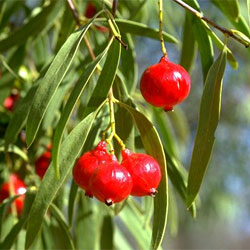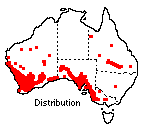Santalum acuminatum
 |
 |
Quandong, Native Peach
Santalum acuminatum (R.Br.) A.DC.
Santalum acuminatum belongs to the Santalaceae family along with the Sandalwood (Santalum album) and Native Cherries (Exocarpos spp.). It is commonly known as the Quandong.
S. acuminatum, like most plants in the Santalaceae, is hemiparasitic. This means that the plant is partially parasitic and relies on host plants for only water and soil nutrients, not for sugars, which is why such parasites have green leaves. These parasites produce a modified root structure called a haustorium, which attaches to a host root and extracts xylem sap. In a natural situation, Santalum seems to rely on nitrogen fixing trees such as Acacia and Casuarina, though it's known to parasitise many other legumes, shrubs, herbs and grasses. Quandong normally has more than one host at a time.
 Quandong
is found in a wide variety of habitats characterised by generally nutrient poor,
free draining soils. It is quite drought and salt tolerant and is likely to
have frost tolerance when mature. It favours full sun.
Quandong
is found in a wide variety of habitats characterised by generally nutrient poor,
free draining soils. It is quite drought and salt tolerant and is likely to
have frost tolerance when mature. It favours full sun.
The variability of S. acuminatum shows in its habit by forming a 1 metre high shrub or a 6 metre high tree. Leaves are 3-9 cm long, an olive colour and are classically eucalypt shaped, often with a sickle like curve. Tiny flowers form racemes in late summer and are insect attracting. Fruits ripen in the following spring, forming a 15-25 mm wide drupe with striking, shiny red skin. Its flesh is about 3-5 mm thick and is prized for food by Aboriginals and Europeans alike. Peaches and other succulent stone fruits have similarly been bred from wild, thin fleshed forms and it looks as though Quandong is heading in the same direction with two cultivars recently made available for commercial production.
Propagation and cultivation has been considered difficult. Seed has a dormancy that is strongest in fresh seeds. One year's ageing raises germination from about 5-30% with three years giving 35% germination, indicating an after ripening requirement. Secondly, as with many hard seed coated species, the testa needs to be broken to induce germination. This can be easily, though carefully, done with a vice. Sow the cracked seed into an appropriate media and keep moist. Germination should occur within a month but may take up to four months. The optimum temperature for germination is 15° C so winter is the best time to sow. When cotyledons have hardened, pot the seedling into free draining media with half strength combined slow and moderate release fertiliser. Seed energy reserves will sustain growth until roots have established.
At this point it is recommended to make a host available. Using one that dominates the pot or crowds the seedling is not advisable because the Quandong has some uptake from its roots and may be outcompeted. Sowing Clover (Trifolium spp.) seed or planting Couch Grass (Cynodon dactylon) cuttings into the pot when transplanting the seedling has proven to be successful, however care is needed as these species can be weedy. The use of a locally indigenous grass or Pea flowering plant is advised. Your local native nursery should be able to advise a suitable species. The Quandong sapling needs to be planted within range of the roots of at least two potential hosts. Ensure a few metres distance between any surrounding trees so its natural form isn't spoilt and make sure it has a full sun. It is critical to maintain the health of host species for the Quandong to perform. Theoretically, this means all plants within at least 10 metres of the Quandong because its roots can reach that far.
If all goes to plan, your climate is not too cold and you have used one of the two available cultivars, you should have spectacularly red ornamental fruits within 4 years.
Text by Justin Teague (2002 Student Botanical Intern)
Name meaning: Santalum acuminatumSantalum - is the Latin form of the Greek word santalon, which means Sandalwood; acuminatum - refers to the acutely shaped leaf tips that are characteristic of this species. |
References
Hewson H.J. & George A.S. 1984. Santalaceae, Flora of Australia, vol. 22. Australian Government Publishing Service, Canberra.
Loveys B.R. & Justias M. 1994. Stimulation of germination of Quandong (Santalum acuminatum) and other Australian native plant seeds. Australian Journal of Botany, 42: pp. 565-574.
Sedgley M. 1982. Preliminary assessment of an orchard of Quandong seedling trees. The Journal of the Australian Institute of Agricultural Science, 48: pp. 52-6.
Tennakoon K.U., Pate J.S. & Arthur D. 1997. Ecophysiological aspects of the woody root hemiparasite Santalum acuminatum (R. Br.) A. DC. and its common hosts in South Western Australia. Annals of Botan, 80: pp. 245-56.
![An Australian Government Initiative [logo]](/images/austgovt_brown_90px.gif)

